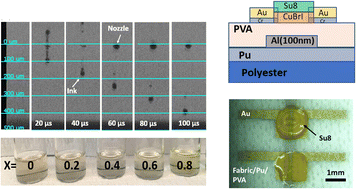Inkjet-printed p-type CuBrxI1−x: wearable thin-film transistors†
Abstract
Printing enabled solution processing of semiconductors, especially Cu-based films, is an inexpensive and low-energy fabrication route for p-type thin-film transistors that are critical components of printed electronics. The state-of-the-art route is limited by a gap between ink compositions that are printable and ink compositions that enable high electrical performance at low processing temperatures. We overcome this gap based on the insight that the hole density of CuI can be tuned by alloying with CuBr while achieving a higher on/off ratio due to the lower formation energy of copper vacancies in CuBr than in CuI. We develop stable and printable precursor inks from binary metal halides that undergo post-printing recrystallization into a dense CuBrI thin film at temperatures as low as 60 °C. Adjusting the CuI/CuBr ratio affects the electrical properties. CuBr0.2I0.8 films achieve the highest field-effect mobility among CuI based thin-film transistors (9.06 ± 1.94 cm2 V−1 s−1) and an average on/off ratio of 102–105 at a temperature of 150 °C. This performance is comparable to printed n-type Cu-based TFT that needs temperatures as high as 400 °C. (mobility = 0.22 cm2 V−1 s−1, on/off ratio = 103). The developed low-temperature processing capability is used to inkjet print textile-based CuBrI thin-film transistors at a low temperature of 60 °C to demonstrate the potential for printing complementary circuits in wearable electronic textiles.



 Please wait while we load your content...
Please wait while we load your content...